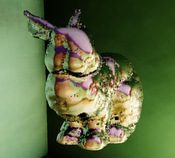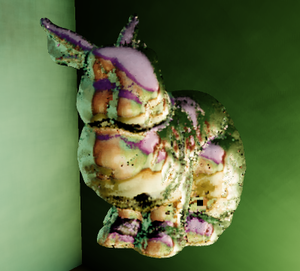Information
- Publication Type: Master Thesis
- Workgroup(s)/Project(s):
- Date: May 2010
- TU Wien Library:
- First Supervisor: Michael Wimmer
- Keywords: mirror space, interactive reflections, curved mirrors, point clouds
Abstract
In the field of real-time rendering, computer graphics observes a continuously growing power of visualizing of scenes of continuously growing complexity. In the past few years, a number of rendering techniques have been developed that let the quality of the rendered images converge towards photorealism. Especially in the field of realistic scene illumination, Global Illumination (GI) techniques represent an important field of research. Previous to this work, for the first time we have applied a GI algorithm also to point clouds, which enables us to achieve realistic illumination of diffuse and glossy objects in real-time. This thesis elevates the power of visualization of this GI-Renderer to the next level. For the first time, it implements a realistic, physically based rendering of mirroring surfaces also for point clouds. Current real-time approaches addressing curved mirroring surfaces in polygon scenes either are extremely imprecise or cannot handle each arbitrary type of surface. Especially concave surfaces represent a significant difficulty for current physically based methods. Up to now, physically correct mirror reflections on complex surfaces can only be produced by offline algorithms. We introduce a novel rendering technique called "Screen-space curved reflections", which enables us to produce physically correct mirror reflections on arbitrarily complex surfaces. Our method bases on the approach, for each point in the scene to find the pixel in the framebuffer that contains its reflecting surface point. This is achieved by the application of a fast 2D root finding in a new error function called "mirror-space error function". Although our method raises high demands on the hardware, we are able to render common scenes at interactive frame rates.Additional Files and Images
Additional images and videos
 image:
mirroring Stanford Bunny point cloud rendered with SSCR
image:
mirroring Stanford Bunny point cloud rendered with SSCR
Additional files
Weblinks
No further information available.BibTeX
@mastersthesis{pr10,
title = "Interactive Curved Reflections in Large Point Clouds",
author = "Reinhold Preiner",
year = "2010",
abstract = "In the field of real-time rendering, computer graphics
observes a continuously growing power of visualizing of
scenes of continuously growing complexity. In the past few
years, a number of rendering techniques have been developed
that let the quality of the rendered images converge towards
photorealism. Especially in the field of realistic scene
illumination, Global Illumination (GI) techniques represent
an important field of research. Previous to this work, for
the first time we have applied a GI algorithm also to point
clouds, which enables us to achieve realistic illumination
of diffuse and glossy objects in real-time. This thesis
elevates the power of visualization of this GI-Renderer to
the next level. For the first time, it implements a
realistic, physically based rendering of mirroring surfaces
also for point clouds. Current real-time approaches
addressing curved mirroring surfaces in polygon scenes
either are extremely imprecise or cannot handle each
arbitrary type of surface. Especially concave surfaces
represent a significant difficulty for current physically
based methods. Up to now, physically correct mirror
reflections on complex surfaces can only be produced by
offline algorithms. We introduce a novel rendering technique
called "Screen-space curved reflections", which enables us
to produce physically correct mirror reflections on
arbitrarily complex surfaces. Our method bases on the
approach, for each point in the scene to find the pixel in
the framebuffer that contains its reflecting surface point.
This is achieved by the application of a fast 2D root
finding in a new error function called "mirror-space error
function". Although our method raises high demands on the
hardware, we are able to render common scenes at interactive
frame rates.",
month = may,
address = "Favoritenstrasse 9-11/E193-02, A-1040 Vienna, Austria",
school = "Institute of Computer Graphics and Algorithms, Vienna
University of Technology ",
keywords = "mirror space, interactive reflections, curved mirrors, point
clouds",
URL = "https://www.cg.tuwien.ac.at/research/publications/2010/pr10/",
}


 poster
poster thesis
thesis
